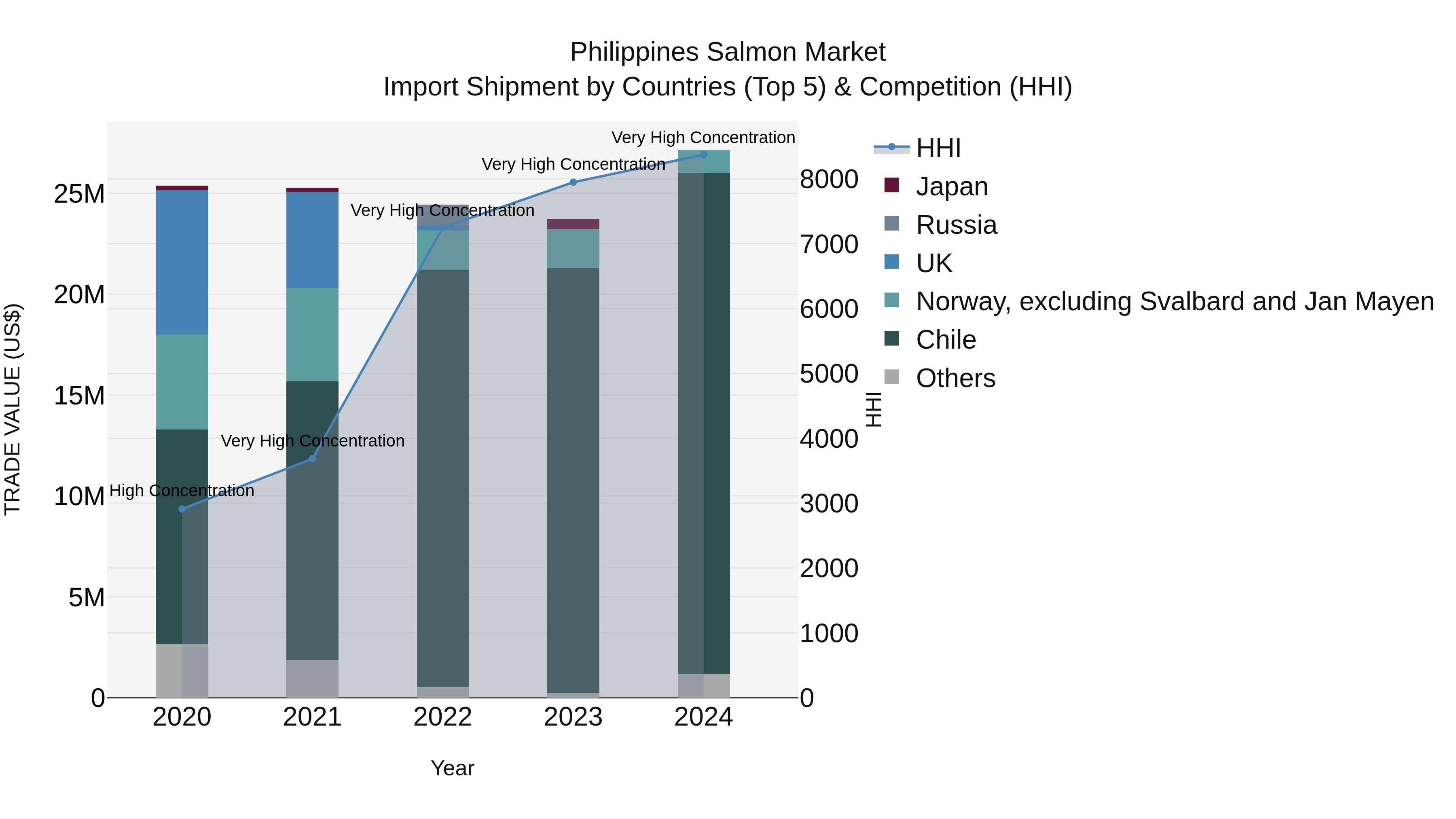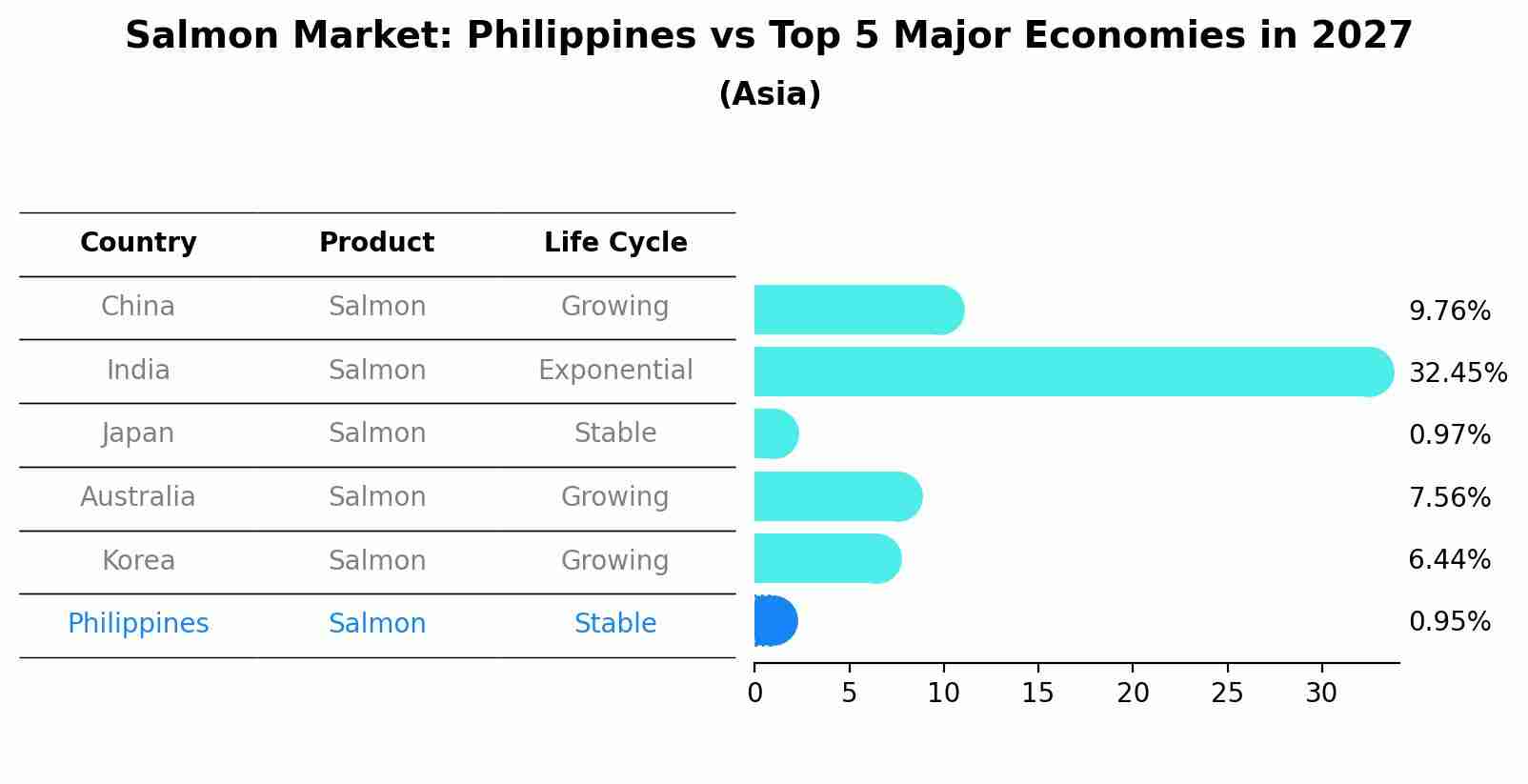Philippines Salmon Market (2025-2031) Outlook | Share, Industry, Companies, Value, Analysis, Forecast, Trends, Growth, Revenue & Size
| Product Code: ETC387629 | Publication Date: Aug 2022 | Updated Date: Nov 2025 | Product Type: Market Research Report | |
| Publisher: 6Wresearch | Author: Ravi Bhandari | No. of Pages: 75 | No. of Figures: 35 | No. of Tables: 20 |
Philippines Salmon Market Top 5 Importing Countries and Market Competition (HHI) Analysis
The Philippines continued to see significant salmon import shipments in 2024, with top exporting countries being Chile, Norway, South Korea, Taiwan, and the USA. Despite a moderate Compound Annual Growth Rate (CAGR) of 1.68% from 2020 to 2024, the market experienced a notable growth spurt in 2024 with a growth rate of 14.39% from the previous year. The high concentration of market share, indicated by the Herfindahl-Hirschman Index (HHI), suggests a competitive landscape dominated by key players, setting the stage for continued growth and competition in the coming years.

Salmon Market: Philippines vs Top 5 Major Economies in 2027 (Asia)
The Salmon market in Philippines is projected to grow at a stable growth rate of 0.95% by 2027, within the Asia region led by China, along with other countries like India, Japan, Australia and South Korea, collectively shaping a dynamic and evolving market environment driven by innovation and increasing adoption of emerging technologies.

philippines salmon market Synopsis
Salmon holds a unique position in the Philippines seafood market as an imported luxury product. Its popularity has been on the rise due to changing culinary preferences and an increasing interest in international cuisines. The market for salmon predominantly caters to upscale restaurants, hotels, and urban households. Despite being a premium product, the salmon market faces challenges related to cost and supply chain logistics. Nevertheless, the market`s growth underscores the evolving tastes of Filipino consumers.
Drivers of the Market
The Philippines salmon market is driven by changing consumer preferences and a growing awareness of the health benefits associated with consuming salmon, which is rich in omega-3 fatty acids. While the country doesn`t have native salmon species, imports cater to the demand for this popular fish. The market growth is also influenced by the expansion of retail chains, restaurants offering international cuisine, and the shift towards healthier eating habits.
Challenges of the Market
The Philippines salmon market faces challenges related to the sourcing of fresh and high-quality salmon products. Salmon is not native to the Philippines, necessitating imports from distant sources. Ensuring the freshness and quality of imported salmon can be challenging due to transportation times and storage conditions. Additionally, market demand for sustainable and responsibly sourced seafood puts pressure on the industry to adhere to environmentally friendly practices and certifications.
COVID-19 Impact on the Market
The Philippines salmon market encountered challenges due to the pandemic. Restrictions on imports and disruptions in the supply chain impacted availability. Closure of restaurants and reduced tourism led to decreased demand. Market recovery required reopening trade channels, restoring supply chains, and rebuilding consumer demand. The market`s rebound also depended on revitalizing the hospitality and foodservice sectors.
Key Players in the Market
The Philippines relies heavily on imported salmon due to its warm climate, and as a result, major international seafood suppliers are key players in this market. Companies like Norway`s Marine Harvest (now Mowi) and other international suppliers dominate the imported salmon market.
Key Highlights of the Report:
- Philippines Salmon Market Outlook
- Market Size of Philippines Salmon Market, 2024
- Forecast of Philippines Salmon Market, 2031
- Historical Data and Forecast of Philippines Salmon Revenues & Volume for the Period 2021-2031
- Philippines Salmon Market Trend Evolution
- Philippines Salmon Market Drivers and Challenges
- Philippines Salmon Price Trends
- Philippines Salmon Porter's Five Forces
- Philippines Salmon Industry Life Cycle
- Historical Data and Forecast of Philippines Salmon Market Revenues & Volume By Type for the Period 2021-2031
- Historical Data and Forecast of Philippines Salmon Market Revenues & Volume By Chinook Salmon for the Period 2021-2031
- Historical Data and Forecast of Philippines Salmon Market Revenues & Volume By Coho Salmon for the Period 2021-2031
- Historical Data and Forecast of Philippines Salmon Market Revenues & Volume By Pink Salmon for the Period 2021-2031
- Historical Data and Forecast of Philippines Salmon Market Revenues & Volume By Red Salmon for the Period 2021-2031
- Historical Data and Forecast of Philippines Salmon Market Revenues & Volume By Salmo Salar for the Period 2021-2031
- Historical Data and Forecast of Philippines Salmon Market Revenues & Volume By Silverbrite Salmon for the Period 2021-2031
- Historical Data and Forecast of Philippines Salmon Market Revenues & Volume By End Product Type for the Period 2021-2031
- Historical Data and Forecast of Philippines Salmon Market Revenues & Volume By Fresh for the Period 2021-2031
- Historical Data and Forecast of Philippines Salmon Market Revenues & Volume By Frozen for the Period 2021-2031
- Historical Data and Forecast of Philippines Salmon Market Revenues & Volume By Canned for the Period 2021-2031
- Historical Data and Forecast of Philippines Salmon Market Revenues & Volume By Others for the Period 2021-2031
- Historical Data and Forecast of Philippines Salmon Market Revenues & Volume By Distribution Channel for the Period 2021-2031
- Historical Data and Forecast of Philippines Salmon Market Revenues & Volume By Retail Stores for the Period 2021-2031
- Historical Data and Forecast of Philippines Salmon Market Revenues & Volume By Hypermarket/supermarket for the Period 2021-2031
- Historical Data and Forecast of Philippines Salmon Market Revenues & Volume By Online Sales Channels for the Period 2021-2031
- Philippines Salmon Import Export Trade Statistics
- Market Opportunity Assessment By Type
- Market Opportunity Assessment By End Product Type
- Market Opportunity Assessment By Distribution Channel
- Philippines Salmon Top Companies Market Share
- Philippines Salmon Competitive Benchmarking By Technical and Operational Parameters
- Philippines Salmon Company Profiles
- Philippines Salmon Key Strategic Recommendations
Frequently Asked Questions About the Market Study (FAQs):
- Single User License$ 1,995
- Department License$ 2,400
- Site License$ 3,120
- Global License$ 3,795
Search
Thought Leadership and Analyst Meet
Our Clients
Related Reports
- Canada Oil and Gas Market (2026-2032) | Share, Segmentation, Value, Industry, Trends, Forecast, Analysis, Size & Revenue, Growth, Competitive Landscape, Outlook, Companies
- Germany Breakfast Food Market (2026-2032) | Industry, Share, Growth, Size, Companies, Value, Analysis, Revenue, Trends, Forecast & Outlook
- Australia Briquette Market (2025-2031) | Growth, Size, Revenue, Forecast, Analysis, Trends, Value, Share, Industry & Companies
- Vietnam System Integrator Market (2025-2031) | Size, Companies, Analysis, Industry, Value, Forecast, Growth, Trends, Revenue & Share
- ASEAN and Thailand Brain Health Supplements Market (2025-2031) | Strategy, Consumer Insights, Analysis, Investment Trends, Opportunities, Growth, Size, Share, Industry, Revenue, Segments, Value, Segmentation, Supply, Forecast, Restraints, Outlook, Competition, Drivers, Trends, Demand, Pricing Analysis, Competitive, Strategic Insights, Companies, Challenges
- ASEAN Bearings Market (2025-2031) | Strategy, Consumer Insights, Analysis, Investment Trends, Opportunities, Growth, Size, Share, Industry, Revenue, Segments, Value, Segmentation, Supply, Forecast, Restraints, Outlook, Competition, Drivers, Trends, Demand, Pricing Analysis, Competitive, Strategic Insights, Companies, Challenges
- Europe Flooring Market (2025-2031) | Outlook, Share, Industry, Trends, Forecast, Companies, Revenue, Size, Analysis, Growth & Value
- Saudi Arabia Manlift Market (2025-2031) | Outlook, Size, Growth, Trends, Companies, Industry, Revenue, Value, Share, Forecast & Analysis
- Uganda Excavator, Crane, and Wheel Loaders Market (2025-2031) | Strategy, Consumer Insights, Analysis, Investment Trends, Opportunities, Growth, Size, Share, Industry, Revenue, Segments, Value, Segmentation, Supply, Forecast, Restraints, Outlook, Competition, Drivers, Trends, Demand, Pricing Analysis, Competitive, Strategic Insights, Companies, Challenges
- Rwanda Excavator, Crane, and Wheel Loaders Market (2025-2031) | Strategy, Consumer Insights, Analysis, Investment Trends, Opportunities, Growth, Size, Share, Industry, Revenue, Segments, Value, Segmentation, Supply, Forecast, Restraints, Outlook, Competition, Drivers, Trends, Demand, Pricing Analysis, Competitive, Strategic Insights, Companies, Challenges
Industry Events and Analyst Meet
Whitepaper
- Middle East & Africa Commercial Security Market Click here to view more.
- Middle East & Africa Fire Safety Systems & Equipment Market Click here to view more.
- GCC Drone Market Click here to view more.
- Middle East Lighting Fixture Market Click here to view more.
- GCC Physical & Perimeter Security Market Click here to view more.
6WResearch In News
- Doha a strategic location for EV manufacturing hub: IPA Qatar
- Demand for luxury TVs surging in the GCC, says Samsung
- Empowering Growth: The Thriving Journey of Bangladesh’s Cable Industry
- Demand for luxury TVs surging in the GCC, says Samsung
- Video call with a traditional healer? Once unthinkable, it’s now common in South Africa
- Intelligent Buildings To Smooth GCC’s Path To Net Zero


















